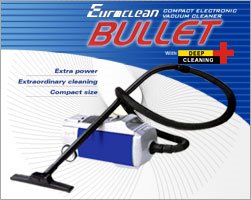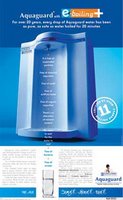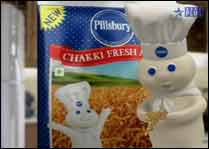Brand : Eureka Forbes
Company: Shahpoorji Pallonji group
Agency: Triton
Eureka Forbes (EFL) have come a long way. From being famous ( or infamous ) for pioneering the direct selling in India to being rated as the best employer and top it all a case study at Harvard.
Eureka Forbes is a joint venture between Forbes ( India ) and Electrolux from Sweden.

Eureka Forbes first launched the Vacuum cleaners in India in 1984 and in 1984 launched the water purifier Aquaguard. EFL initially faced lot of problem in marketing its vacuum cleaners. Targeted at the upper middle class families, these products were never considered a priority. Since most of the middle class families could afford a maid, it was a fight between Maid and the Machine.
Because of the low interest and since the product benefits needs to be demonstrated to the customers, conventional distribution was not viable. Hence EFL chose the less traveled Direct selling route. The Eureka Forbes sales man was called Eurochamp. It was a tough job for these salesman who had to go through the "cold calls " to get a sale. At one point of time, because of the aggressive nature of these sales persons, people became scared even to listen to these sales persons. Now this aggression has mellowed down to a more professional sales approach. EFL has also tried to position their sales persons as problem solvers rather than sales officers. The campaigns tried to build the image of a Euro champ as a Friend rather than one that is after the money.During the late eighties, Eureka Forbes salesmen was generic to direct selling.
 Indian vacuum cleaner market is worth around 120 crores and water purifier market is worth around 350 crores. EFL is a clear market leader in both these categories with a market share of 85%.
Indian vacuum cleaner market is worth around 120 crores and water purifier market is worth around 350 crores. EFL is a clear market leader in both these categories with a market share of 85%.
Aquaguard water purifier was a clear winner from EFL stable . Targeted at the top of SEC households, this brand has effectively positioned itself as a one stop shop for pure water. This brand connects very well with the concern of mothers about the purity of the water at home.
Company: Shahpoorji Pallonji group
Agency: Triton
Eureka Forbes (EFL) have come a long way. From being famous ( or infamous ) for pioneering the direct selling in India to being rated as the best employer and top it all a case study at Harvard.
Eureka Forbes is a joint venture between Forbes ( India ) and Electrolux from Sweden.

Eureka Forbes first launched the Vacuum cleaners in India in 1984 and in 1984 launched the water purifier Aquaguard. EFL initially faced lot of problem in marketing its vacuum cleaners. Targeted at the upper middle class families, these products were never considered a priority. Since most of the middle class families could afford a maid, it was a fight between Maid and the Machine.
Because of the low interest and since the product benefits needs to be demonstrated to the customers, conventional distribution was not viable. Hence EFL chose the less traveled Direct selling route. The Eureka Forbes sales man was called Eurochamp. It was a tough job for these salesman who had to go through the "cold calls " to get a sale. At one point of time, because of the aggressive nature of these sales persons, people became scared even to listen to these sales persons. Now this aggression has mellowed down to a more professional sales approach. EFL has also tried to position their sales persons as problem solvers rather than sales officers. The campaigns tried to build the image of a Euro champ as a Friend rather than one that is after the money.During the late eighties, Eureka Forbes salesmen was generic to direct selling.
 Indian vacuum cleaner market is worth around 120 crores and water purifier market is worth around 350 crores. EFL is a clear market leader in both these categories with a market share of 85%.
Indian vacuum cleaner market is worth around 120 crores and water purifier market is worth around 350 crores. EFL is a clear market leader in both these categories with a market share of 85%.Aquaguard water purifier was a clear winner from EFL stable . Targeted at the top of SEC households, this brand has effectively positioned itself as a one stop shop for pure water. This brand connects very well with the concern of mothers about the purity of the water at home.
Innovative products like water purifier with 'e-Boiling' together with communications clearly telling the benefits of this product has made Aquaguard a " Super Brand".
One of the major problems faced by both these markets is the price barrier. Vacuum cleaners were expensive when it was launched, but looking at the website of the company, the prices has come down sharply which will expand the market. Second problem with vacuum cleaner is the lack of product usage at homes. Most of the vacuum cleaners are lying idle which is bound to create a negative word of mouth. EFL may have to do a follow up on helping customers to use the product regularly. Water purifier may not have the usage problem but the price is still considered as high by the middle class. EFL may have to launch some economic brand as a flanker to Aquaguard.
Eureka Forbes is a brand that personifies the hard work of all Euro champs. hats off to them.










